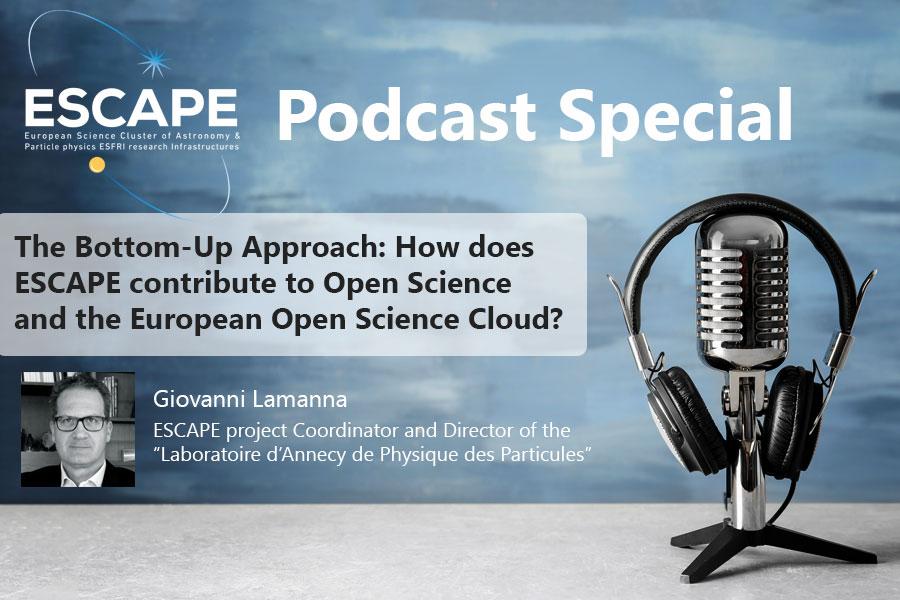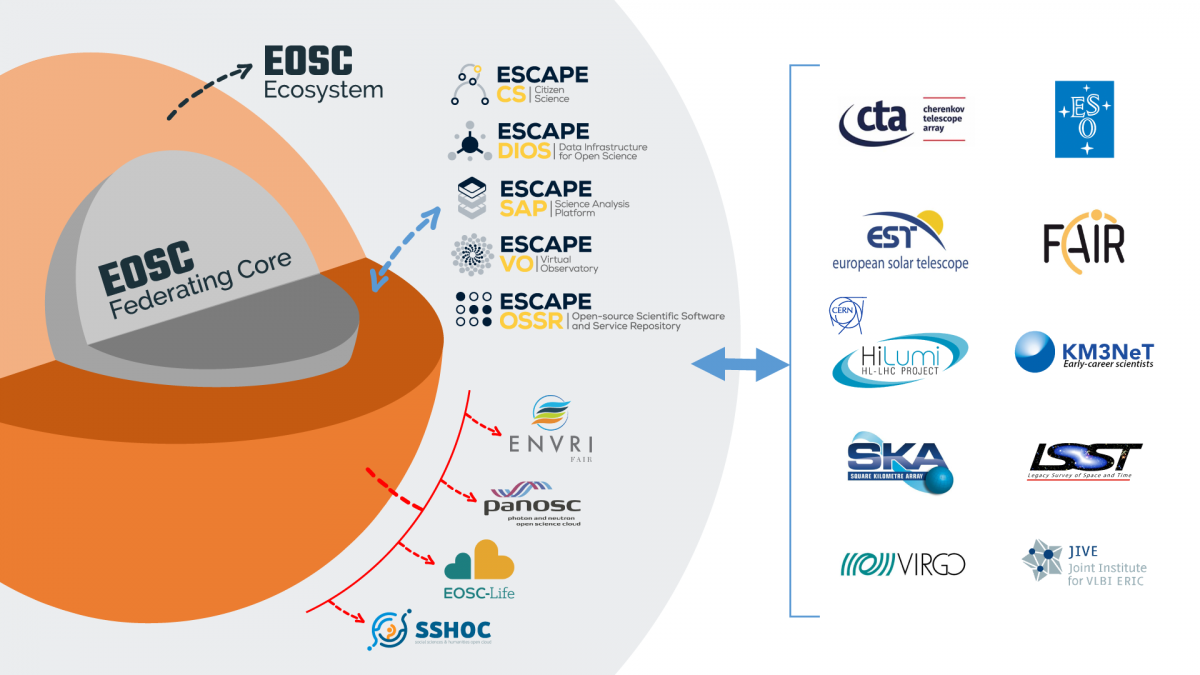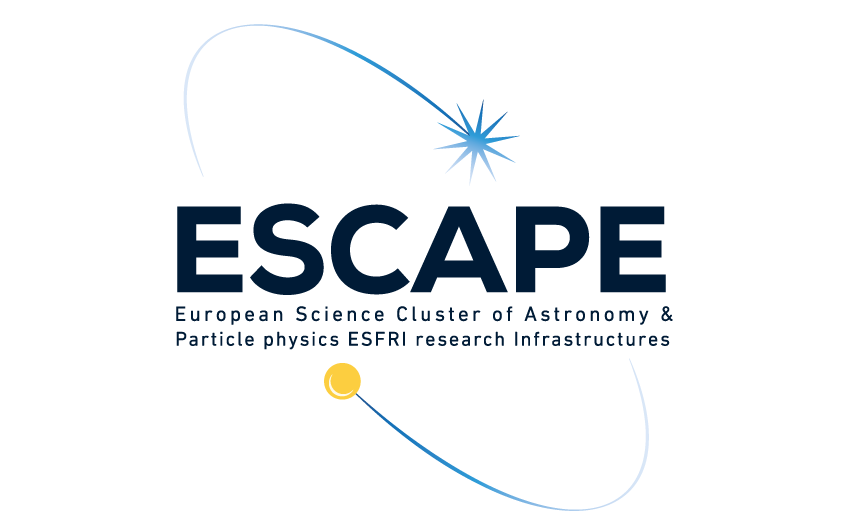

Open Science represents a new approach to the scientific process, based on cooperative work and new ways of diffusing knowledge by using digital technologies and new collaborative tools. It is about extending the openness of the whole research, while fostering sharing and collaboration as early as possible and entailing a systemic change to the way science and research is done.
This is not yet a reality and the European Open Science Cloud (EOSC) is the European Commission initiative to promote open science practices across Europe, through a number of different projects, including ESCAPE. ESCAPE is a Horizon 2020 project which fulfils the EOSC ambition in creating a cross border and multidisciplinary environment to enable EOSC to adopt services, e-infrastructures and data stewardship of European Strategy Forum on Research Infrastructures (ESFRI) projects across users.
Giovanni Lamanna, ESCAPE cluster project coordinator and Director of the “Laboratoire d’Annecy de Physique des Particules”, a research laboratory in particle and astroparticle physics, explains in a 45min podcast how ESCAPE fits into this EOSC vision, as well as what is the key for EOSC to work, amongst others things. The podcast, heavy content-wise, provides a nice overview about open science and what needs to be done to ensure its success and sustainability in the long term. A quick overview of the main ideas discussed is available below.
The Key for Open Science: Work together, work together and work together
It is clear that open science is a hot topic in international political programmes. However, according to Giovanni, society, from citizens to public investors, needs to change the way it approaches research.
The biggest challenge is to pursue the involvement of researchers in open science. To accelerate scientific discoveries and increase their scientific value, players need to share their data and transfer this knowledge within the scientific community. Researchers need to dare to stop hiding in their ivory towers and work together in a holistic approach, bringing together researchers from different projects and, especially, disciplines. Visions need to be aligned between the 5 cluster projects (SSHOC – Social Sciences and Humanities, PANOSC – Photon and Neutron, ENVRI-FAIR - Environment, EOSC-LIFE – Biological and Medical) in terms of training, data interoperability, joint test science projects (TSPs) to create economies of scale in European science. This is one of the goals ESCAPE is pursuing.
Only by reusing, reproducing and combining scientific data from different disciplines, will society be able to get new results and make innovative discoveries (e.g. create brand new data on how to recuperate the waste when cooling circuits, how to use technology to store energy) that can contribute to other European initiatives such as the Green Deal (aiming to make the EU's economy sustainable). Today’s society, thanks to technology and social networks, shares opinions, pictures and all kinds of content. It is time to replicate this “culture of sharing” in science and create today a reference for any coming big science facility
ESCAPE Open Science Vision – the ESCAPE Cell
Based on both open science vision and the needs of RIs part of ESCAPE, the project is developing its own implementation of EOSC, known as EOSC Cell, where researchers will be supported in 3 main ways:
- Services for big data orchestration and management, without compromising interoperability (ESCAPE DIOS);
- A catalogue, populated by scientists, of digital outputs, namely software to analyse and reproduce scientific results and new workflows developed by scientists, which other scientists can use to develop new software that will be useful for other scientific domains (ESCAPE OSSR);
- A web-based scientific analysis platform/gateway, through which the new generation researcher can have their own scientific platform, and build workflows that will be included in the catalogue and support other researchers (ESCAPE SAP).
ESCAPE is creating a cross border and multidisciplinary environment to enable EOSC to adopt services, e-infrastructures and data stewardship of ESFRI projects. More information about ESCAPE services is available on the ESCAPE website.
Putting researchers in the centre of the EOSC – ESCAPE Test Science Projects
The RIs, researchers and scientists need to be at the centre of the endeavour of open science. They need to commit to the implementation of the EOSC and go beyond managing RIs to developing tools and processes that are dynamic, to support a wider range of researchers. The RIs, which are data producers, are also the ones who need to commit to data quality and standards, as well as turn this data into FAIR. It is crucial to engage with them, to ensure EOSC’s sustainability and this is why ESCAPE is working with 10 ESFRI projects, which are committed to open science and willing to join EOSC.

For a cross fertilization environment, crucial for open science, ESCAPE is developing TSPs, where researchers from different disciplines come together to combine their real data and validate prototypes being developed in ESCAPE. The ESCAPE TSPs will leverage on each ESFRI and ESCAPE service, to add know-how and create a permanent platform for different communities and, consequently, fertilize opportunities for mutual benefits. The results will be available in an open shared way, which is just what EOSC is aiming for. One of the TSPs from ESCAPE is the Dark Matter one, bringing together particle physics theorists and astrophysicists with a wide range of interests, as well as particle/astroparticle physics experimentalists focusing on collider, fixed-target, beam-dump, direct and indirect DM detection experiments, as well as dedicated axion/ALP experiments.
A successful TSP will open up the path for the next research and innovation framework programme from the European Commission, known as Horizon Europe, where “Excellence Science” is one of the key pillars, aimed at reforming and enhancing the European RI system.
Listen to the complete podcast below
Subscribe to our newsletter to be the first to hear the latest ESCAPE updates
Views
37,688

